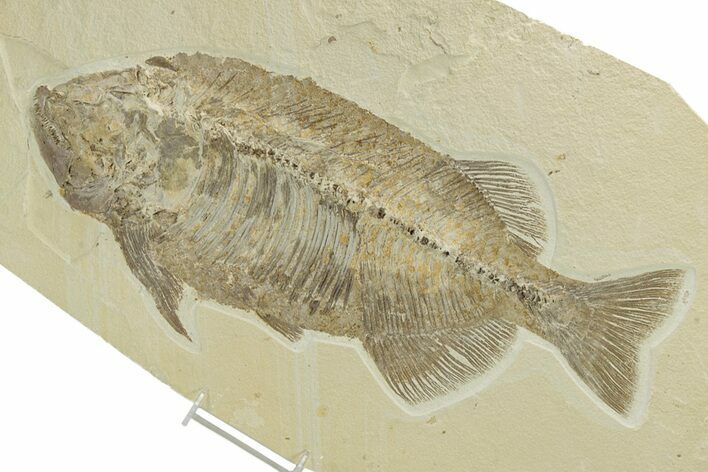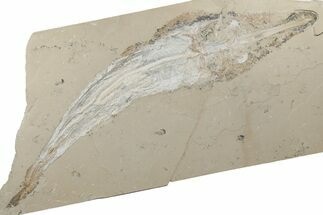This Specimen has been sold.
Monster, 20.5" Fossil Fish (Phareodus) - Check Out The Teeth!
This is a superb, 20.5" long example of one of the more uncommon fossil fish found in the Green River Formation, Phareodus. It is huge, remarkably detailed, and nicely presented on a 27.2 x 15.8" slab of shale. The teeth and bone preservation is phenomenal! Just check out the closeup photos to see the detail in this magnificent specimen.
There are repaired cracks running through the rock next to the head, however none of these cracks go through the fish. There may be some spots where the facial bones broke free, requiring some minor repair, however the entire specimen is incredibly intact with minimal repair. The shale has been backed with a hardie board for stability and to make it easy to mount on a wall. Upon request, we can install a french cleat wall hanger, otherwise the specimen will be accompanied by a rebar display stand.
There are repaired cracks running through the rock next to the head, however none of these cracks go through the fish. There may be some spots where the facial bones broke free, requiring some minor repair, however the entire specimen is incredibly intact with minimal repair. The shale has been backed with a hardie board for stability and to make it easy to mount on a wall. Upon request, we can install a french cleat wall hanger, otherwise the specimen will be accompanied by a rebar display stand.
About Phareodus
Phareodus is a genus of predatory freshwater fish found in the famous Fossil Lake deposits of the Green River Formation in Wyoming. It had a mouthful of sharp pointy teeth, making it a voracious lake predator. In fact, the name Phareodus actually means "to have teeth". Spines from other fish such as Mioplosus and Priscacara have frequently been found preserved in their stomachs.
Phareodus is a genus of predatory freshwater fish found in the famous Fossil Lake deposits of the Green River Formation in Wyoming. It had a mouthful of sharp pointy teeth, making it a voracious lake predator. In fact, the name Phareodus actually means "to have teeth". Spines from other fish such as Mioplosus and Priscacara have frequently been found preserved in their stomachs.
About Fossil Lake
50 million years ago, in the Eocene epoch, these fish thrived in Fossil Lake, which was fed by the Uinta and Rocky Mountain highlands. The anoxic conditions at the bottom of Fossil Lake slowed bacterial decomposition, prevented scavengers from disturbing corpses, and, most interestingly, suffocated creatures that ventured into the oxygen-starved aquatic layer. The result is a miraculous exhibition of Eocene biota: a subtropical aquatic community within sycamore forests, teeming with creatures such as freshwater stingrays, dog-sized horses, menacing alligators, early flying bats, and one of the first primates.
50 million years ago, in the Eocene epoch, these fish thrived in Fossil Lake, which was fed by the Uinta and Rocky Mountain highlands. The anoxic conditions at the bottom of Fossil Lake slowed bacterial decomposition, prevented scavengers from disturbing corpses, and, most interestingly, suffocated creatures that ventured into the oxygen-starved aquatic layer. The result is a miraculous exhibition of Eocene biota: a subtropical aquatic community within sycamore forests, teeming with creatures such as freshwater stingrays, dog-sized horses, menacing alligators, early flying bats, and one of the first primates.
SPECIES
Phareodus testis
LOCATION
Fossil Safari Quarry, Kemmerer, Wyoming
FORMATION
Green River Formation
SIZE
20.5" long on 27.2 x 15.8" rock
CATEGORY
SUB CATEGORY
ITEM
#207848
We guarantee the authenticity of all of our specimens.
 Reviews
Reviews


















